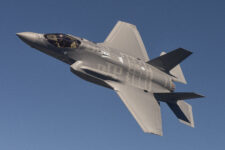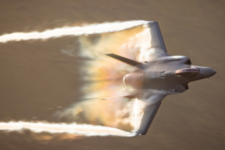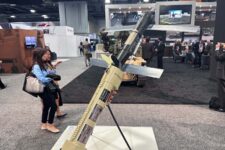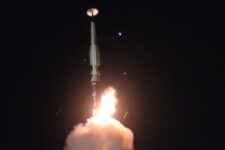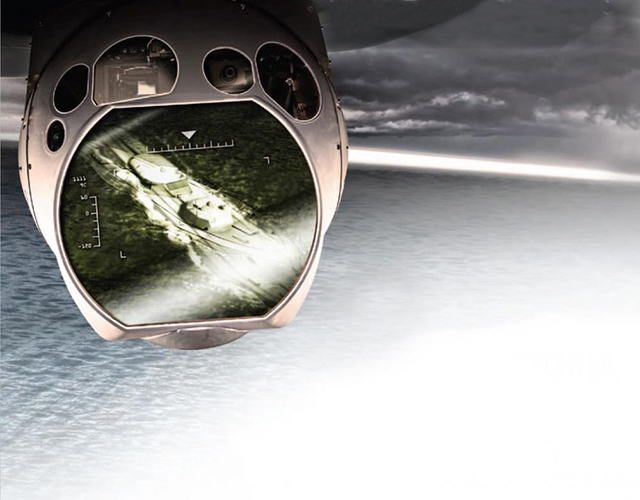
The Multi-Spectral Targeting System is a turreted electro-optical and infrared sensor used in maritime and overland intelligence, surveillance and reconnaissance (ISR) missions. Raytheon Intelligence and Space is integrating artificial intelligence and machine learning across ISR capabilities to help warfighters make decisions faster with reduced workload. (Raytheon Technologies photo illustration created by Grant Parsley)
If a swarm of heavily armed fast boats barreled full speed at an aircraft carrier, the crew would have very little time to react.
But if that crew had artificial intelligence and machine learning at its disposal, that blitz of boats probably wouldn’t pose nearly as much of a problem.
Raytheon Intelligence & Space, one of four businesses that form Raytheon Technologies, is using artificial intelligence and machine learning to improve the intelligence, surveillance and reconnaissance capabilities of the U.S. and allied armed forces. The approach is to synthesize reams of data into actionable intelligence and accurate targeting information at speed and scale, in high-risk environments.
“In multi-domain operations, you don’t have full domain superiority but have to exploit what they call moments of superiority in the battlefield,” said Jim Wright, RI&S’ technical director for Intelligence, Surveillance and Reconnaissance Systems. “Speed is a big issue in this defense strategy, which is challenged by huge amounts of data and a limited number of people to look at it.”
A military customer once told Wright the armed services collect 22 football seasons’ worth of video every day. That’s far too much to sift through manually – especially when operators have to make critical decisions quickly, such as protecting ships in crowded sea lanes.
“We’re looking at how machine learning can augment our existing sensor product lines and the question is: ‘How can we utilize machine learning technology to help military commanders make decisions?’” said Shane Zabel, AI Technology Area director for RI&S. “How do we embed some kind of learning machine to go with the sensors to help better execute the mission?”
Traditionally, operators have control sensors and analyzed data much like you’d think they would – by keeping their eyes locked on screens, pressing buttons and using joysticks to move things around. RI&S is using military and commercial advancements in technology to automate those functions.
“AI/ML is at the core of our technology roadmap across Raytheon Intelligence & Space,” said Barbara Borgonovi, vice president of Intelligence Surveillance and Reconnaissance Systems at RI&S. “We are implementing AI/ML into next-generation ISR capabilities so operators can rapidly make the right decisions in any threat environment.”
The business is also developing smart software called Cognitive Aids to Sensor Processing, Exploitation and Response (CASPERTM), to lighten the operator’s workload and use automation to help make decisions faster.
The aids interpret operator requests, then control sensor and data processing functions. They are being integrated into products like the Multi-Spectral Targeting System, which provides visible and infrared intelligence and targeting information for an array of airborne platforms.
CASPER allows operators to work above the drudgery of data processing and instead focus on decision making, resulting in exponentially faster threat response.
Take the fast boat scenario, for example.
“Much like talking to Alexa or Siri, an operator tells CASPER to scan for fast boats and prioritize by threat to the carrier,” Wright said. “CASPER then takes control of sensor functions, rapidly identifies which boats are threats based on things like their appearance and behavior over space and time, and provides the operator with the threat list and recommended courses of action.
“This enables the operator to focus attention on ensuring recommendations are correct and consistent with policy, making the whole process shorter and safer,” he said.
RI&S is developing advanced automation capabilities for ground station systems, and is advancing these capabilities to the leading edge of the sensor grid.
There are thousands of systems and sensors in today’s battlespace. Automation will also help deliver the right data at the right time to make decisions faster through another transformative solution – Joint All Domain Command and Control (JADC2). JADC2 is a future command and control network that will link capabilities and military platforms across the globe in all domains – air, land, sea, cyber and space.
“Machine learning has really taken off,” Zabel said. “It’s all about harnessing the speed potential AI and ML offer.”
Learn more about Raytheon Intelligence & Space’s Decision Superiority solutions here.
